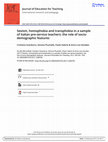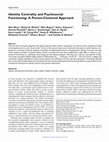Papers by Simona Picariello

Although recent research has highlighted that lesbian, gay, bisexual and transgender (LGBT) youth... more Although recent research has highlighted that lesbian, gay, bisexual and transgender (LGBT) youths represent a resilient population, they still suffer from social stigma and oppression, being potentially at additional risk of developing negative mental health outcomes. One of the main environments where violence and harassment against this population are present is the school. Within school contexts, the impact that teachers can have on the educational experiences of LGBT youths seems to be a crucial point. This paper explored sexist, homophobic and transphobic attitudes among 438 pre-service teachers in relation to specific socio-demographic features. Results indicated that being male, heterosexual, conservative and currently religious were positively associated with sexist, homophobic, and transphobic attitudes and feelings, and having a LGBT friend was negatively associated with homophobic and transphobic attitudes and feelings. These results suggest the need to introduce specific training on the deconstruction of gender and sexual stereotypes and prejudices, to provide teachers with efficient tools to address diversity in the classrooms and to implement inclusive school policies. Suggestions for the implementation of good practices are provided.

International Journal of Transgenderism, 2015
Although attachment theory has been recognized as one of the main reference for the study of the ... more Although attachment theory has been recognized as one of the main reference for the study of the general wellbeing, little research has been focused on the attachment styles of transgender people. Attachment styles are deeply influenced by the earliest relationships with caregivers, which, for gender nonconforming children, are often characterized by parental rejection. Consequently, transgender children and adults likely internalize societal stigma, developing internalized transphobia. The current research was aimed to explore the link between adult attachment and internalized transphobia. 25 male-to-female (MtF) and 23 female-to-male (FtM) transgender people participated in the survey filling in two self-report questionnaires: the Attachment Style Questionnaire and the Transgender Identity Survey. A cluster analysis, T-Test and multiple regression analysis were conducted to explore the link between attachment styles and internalized transphobia. A greater prevalence of secure attachment styles was detected. Participants with secure attachment styles reported higher levels of positive transgender identity than those with insecure attachment styles. Secure attachment styles significantly affect positive transgender identity, while insecure attachment styles influence internalized transphobia. A clinical focus on the redefinition of the Internal Working Models of transgender people can inform psychologically-focused interventions, which transgender people can benefit from.

Sexism, heteronormativity and homo/transphobia are pervasive in every social institutions. In spo... more Sexism, heteronormativity and homo/transphobia are pervasive in every social institutions. In sport such culture is evident because the cultural frame is represented by a very strong sex-segregation. The marked difference between males and females can produce dangerous gender stereotypes facilitating the development of a heterosexist culture. Heterosexism is an integral part of the male identity and seems to be particularly evident in team sports. Men socialize their own identity in opposition to the feminine one perceiving themselves as stronger and more powerful. This dynamic creates serious problems for sexual minority youths who are affected by homophobia and genderism. The purpose of this study was to explore knowledge, opinions and attitudes related to gender and sexual issues in sport among 111 undergraduates attending the faculty of Movement Science at Parthenope University of Naples. Participants completed a questionnaire containing many questions about gender and sexual is...
Sono caduta dalle scale. I luoghi e gli attori della violenza di genere. [I fell down the stairs. Places and actors of gender violence] (Eds. Caterina Arcidiacono & Immacolata Di Napoli)

Emerging Adulthood
There has been increased recognition that identity operates within several “components” and that ... more There has been increased recognition that identity operates within several “components” and that not every component is likely to be equally central to one’s sense of self. The aim of the current study was to determine the extent to which identity components (i.e., personal, relational, collective, and public) are differentially central to emerging adults’ identity. We used a two-step cluster analytic procedure to identify distinct clusters and determine how these configurations might differ in relation to psychosocial functioning (i.e., well-being, externalizing and internalizing symptoms, illicit drug use, risky sex, and impaired driving). The sample consisted of 8,309 college students (72.8% female; Mage = 19.94 years, 18-29, SD = 2.01) from 30 U.S. colleges and universities. Analyses identified six unique clusters based on the centrality of the four identity components. The findings indicated that a more well-rounded identity was associated with the most favorable psychosocial f...

International Journal of Transgenderism, 2015
ABSTRACT. Introduction: Although attachment theory has been recognized as one of the main referen... more ABSTRACT. Introduction: Although attachment theory has been recognized as one of the main references for the study of the general well-being, little research has been focused on the attachment styles of transgender people. Attachment styles are deeply influenced by the earliest relationships with caregivers, which, for gender-nonconforming children, are often characterized by parental rejection. Consequently, transgender children and adults likely internalize societal stigma, developing internalized transphobia. The current research was aimed to explore the link between adult attachment and internalized transphobia. Method: Twenty-five male-to-female (MtF) and 23 female-to-male (FtM) transgender people participated in the survey filling in two self-report questionnaires: the Attachment Style Questionnaire and the Transgender Identity Survey. A cluster analysis, t-test, and multiple regression analysis were conducted to explore the link between attachment styles and internalized transphobia. Results: A greater prevalence of secure attachment styles was detected. Participants with secure attachment styles reported higher levels of positive transgender identity than those with insecure attachment styles. Secure attachment styles significantly affect positive transgender identity, while insecure attachment styles influence internalized transphobia. Conclusions: A clinical focus on the redefinition of the internal working models of transgender people can inform psychologically focused interventions that transgender people can benefit from. KEYWORDS. Adult attachment styles, internalized transphobia, transgender identity, stigma

The present study was conducted to contribute to our understanding of young adult identity develo... more The present study was conducted to contribute to our understanding of young adult identity development by deriving
latent profiles from intrapersonal and interpersonal indices of identity synthesis and confusion. A sample
of 9737 college-attending young adults completed measures of identity, mental health, and health risk behaviors.
Four latent profiles emerged: Synthesized (high synthesis, low confusion), Diffused (moderate synthesis, high
confusion), Elevated (high synthesis and confusion), and Moderate (moderate synthesis and confusion). The
Synthesized profile was associated with the highest well-being and the lowest levels of internalizing, externalizing,
and health risks. The Diffused and Elevated profiles were both associated with low well-being and with high
internalizing, externalizing, and risky behaviors — with the Elevated profile highest on all of the negative outcomes.
The Moderate profile scored intermediately on well-being, internalizing, externalizing, and health risks.
These results are discussed in terms of the role of identity within a successful transition to adulthood.
Books by Simona Picariello
Bioethical Issues by the Interuniversity Centre for Bioethics Research (C.I.R.B.), 2013
proprietà letteraria riservata Tutti i diritti (traduzione, adattamento) sono riservati per tutti... more proprietà letteraria riservata Tutti i diritti (traduzione, adattamento) sono riservati per tutti i Paesi. La riproduzione, anche parziale, e con qualsiasi mezzo (compresi microfilm e fotostatiche) è vietata.
Hermes. Linking network to fight sexual and gender stigma. A.L. Amodeo & P. Valerio (Eds.), 2014
Sono caduta dalle scale: i luoghi e gli attori della violenza di genere - Arcidiacono, C., di Napoli, I., 2012







Uploads
Papers by Simona Picariello
latent profiles from intrapersonal and interpersonal indices of identity synthesis and confusion. A sample
of 9737 college-attending young adults completed measures of identity, mental health, and health risk behaviors.
Four latent profiles emerged: Synthesized (high synthesis, low confusion), Diffused (moderate synthesis, high
confusion), Elevated (high synthesis and confusion), and Moderate (moderate synthesis and confusion). The
Synthesized profile was associated with the highest well-being and the lowest levels of internalizing, externalizing,
and health risks. The Diffused and Elevated profiles were both associated with low well-being and with high
internalizing, externalizing, and risky behaviors — with the Elevated profile highest on all of the negative outcomes.
The Moderate profile scored intermediately on well-being, internalizing, externalizing, and health risks.
These results are discussed in terms of the role of identity within a successful transition to adulthood.
Books by Simona Picariello
latent profiles from intrapersonal and interpersonal indices of identity synthesis and confusion. A sample
of 9737 college-attending young adults completed measures of identity, mental health, and health risk behaviors.
Four latent profiles emerged: Synthesized (high synthesis, low confusion), Diffused (moderate synthesis, high
confusion), Elevated (high synthesis and confusion), and Moderate (moderate synthesis and confusion). The
Synthesized profile was associated with the highest well-being and the lowest levels of internalizing, externalizing,
and health risks. The Diffused and Elevated profiles were both associated with low well-being and with high
internalizing, externalizing, and risky behaviors — with the Elevated profile highest on all of the negative outcomes.
The Moderate profile scored intermediately on well-being, internalizing, externalizing, and health risks.
These results are discussed in terms of the role of identity within a successful transition to adulthood.